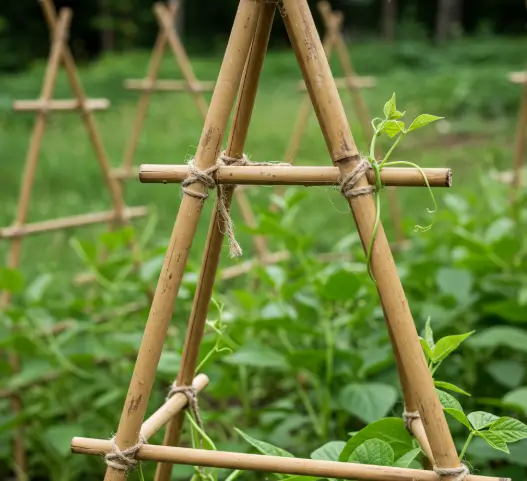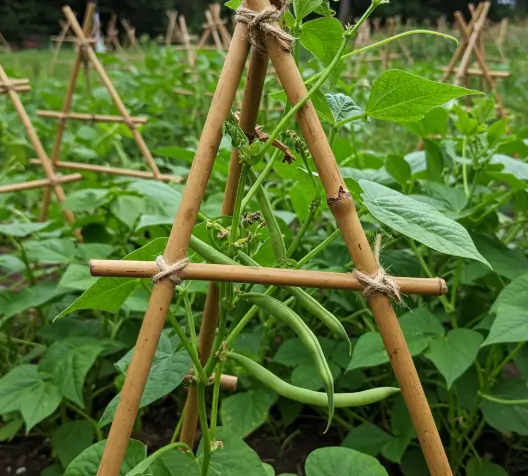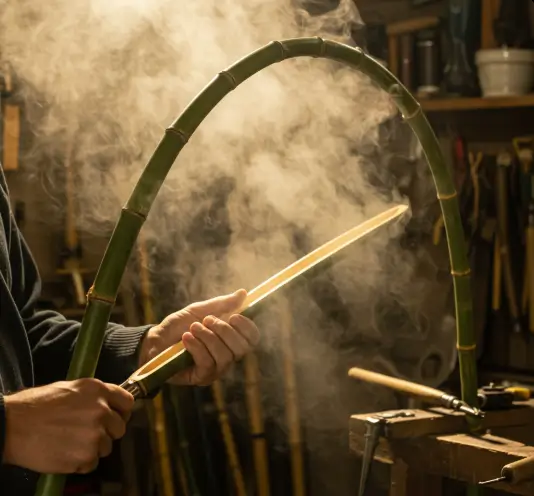Why Choose a Bamboo Trellis?
The Natural Beauty and Sustainability of Bamboo
Growing up, I often spent weekends at my Mexican neighbor’s home, Señora Alvarez, whose vibrant backyard was filled with a labyrinth of bamboo garden trellis. I remember helping her weave fresh bamboo poles into beautiful arches while she explained how bamboo was a gift from nature — fast-growing, strong, and breathtakingly beautiful.
Bamboo is a material celebrated for both its strength and sustainability. Unlike hardwood trees, which may take decades to mature, bamboo can reach full height within a few months. It regenerates naturally without replanting, making it one of the most renewable materials available for gardeners seeking eco-friendly solutions. Its light color, smooth texture, and elegant simplicity can enhance any garden setting, blending harmoniously with a variety of plants and landscape designs.
Furthermore, using bamboo for trellis construction supports environmental stewardship by reducing the demand for synthetic materials that contribute to pollution. In my gardening projects, I have found bamboo not only visually appealing but also incredibly durable when treated properly, lasting several seasons with minimal maintenance.
Benefits of Using Bamboo in Garden Structures
Beyond aesthetics, bamboo offers practical benefits in the garden. It is extremely lightweight yet possesses tensile strength comparable to steel. This makes it an ideal choice for building sturdy, flexible trellises that can support heavy climbing plants such as tomatoes, cucumbers, and flowering vines.
In addition:
- Bamboo is highly versatile; it can be bent, shaped, and tied easily.
- Trellises made from bamboo resist harsh weather conditions when treated properly.
- Bamboo’s natural resistance to pests (compared to untreated wood) extends the life of your garden structures.
Choosing bamboo is a choice rooted in respect for nature, functionality, and timeless beauty.

Table of Contents
Essential Tools and Materials for DIY Bamboo Trellises
Basic Tools You’ll Need for Building
When I first decided to build my homemade bamboo trellis, I underestimated how simple the tool list would be. Its simplicity is elegant. To begin your DIY project, you will need the following tools:
- Sharp handsaw or pruning saw
- Strong garden shears
- Measuring tape
- Pencil or chalk for marking
- Electric drill (optional for sturdier fastenings)
- Twine, jute cord, or garden wire
Each of these items can be found easily at most home improvement stores, and many are likely already in your gardening toolkit. The key is to ensure that your cutting tools are sharp and precise, which makes working with bamboo significantly easier and safer.
Choosing the Right Bamboo: Fresh vs. Cured
Selecting the right type of bamboo is crucial for a successful trellis. I vividly recall my first mistake: using green, freshly cut bamboo that warped under the sun within days. Now, I always use cured bamboo poles — bamboo that has been dried and treated to resist pests and decay.
Key points when choosing bamboo:
- Fresh bamboo: Easy to bend but prone to shrinking and cracking.
- Cured bamboo: Harder to bend but offers superior longevity.
- Choose straight, thick-walled poles for load-bearing parts of the trellis.
If possible, purchase pre-cured bamboo poles from reputable garden suppliers or allow harvested bamboo to dry naturally in a shaded area for a few weeks before use.
How to Make a Plant Trellis with Bamboo
Simple Step-by-Step Guide for Beginners
On a warm Saturday morning, my mother and I set out to build a simple trellis for our burgeoning tomato patch. The method was straightforward, and the rewards were immense. To make a basic DIY plant support from bamboo, follow these steps:
- Measure and Cut: Determine the desired height and width of your trellis. Cut the bamboo poles accordingly.
- Layout Design: Arrange the poles on the ground to form your basic structure (A-frame, lattice, etc.).
- Secure Joints: Bind the intersecting points with strong jute twine or garden wire, ensuring a tight and secure fit.
- Anchor the Base: Push or bury the bamboo ends into the soil at least 8 inches deep for stability.
- Inspect Stability: Gently shake the trellis; it should remain firm and upright.
Patience and care in the binding process make all the difference in the longevity of your bamboo structure.
Creative Tips for Designing Your Style
Once you have mastered the basics, the real fun begins. Customize your bamboo trellis construction to reflect your garden’s theme:
- Incorporate Artistic Patterns: Weave the bamboo into geometric or abstract shapes.
- Add Decorative Knots: Learn simple lashing techniques like square lashing for extra aesthetic appeal.
- Paint or Stain: While natural bamboo is beautiful, staining it with eco-friendly oils can add color and additional protection.
By combining creativity with functionality, your garden can become a living art exhibit, showcasing both your plants and your handiwork.
7 DIY Bamboo Trellis Ideas to Try
1. Classic A-Frame Bamboo Trellis
One sunny afternoon, my Aunt Rosa invited me over to help build an A-frame trellis for her pole beans. The simple bamboo trellis we created looked rustic yet elegant, and it proved incredibly sturdy.
An A-frame trellis is made by leaning two bamboo panels together at an angle and connecting them at the top. The slanted structure allows vines to climb naturally while providing easy access for harvesting.
Building Tips:
- Use thicker poles for the frame and thinner bamboo for cross-supports.
- Lash intersections tightly with jute or coated garden wire for added durability.
2. Fan-Style Bamboo Trellis for Climbing Plants
This artistic design spreads bamboo poles outward from a single anchor point, resembling an open fan. It works perfectly for lighter climbers like morning glories or sweet peas.
How to Create It:
- Anchor the base with sturdy stakes.
- Splay poles outwards evenly.
- Connect poles with horizontal strips at intervals for additional support.
Fan-style trellises add a dramatic flair to any garden corner.
3. Flat Wall-Mounted Bamboo Trellis
Inspired by Señora Alvarez’s garden walls, I built a vertical bamboo garden structure against my backyard fence. Flat trellises are ideal for maximizing small spaces.
Installation Steps:
- Arrange bamboo poles in a vertical grid directly against a wall.
- Fasten securely using wall hooks or brackets.
- Train your vines upward for a lush green wall effect.

4. Teepee-Style Bamboo Trellis for Vegetables
Teepee trellises are perfect for crops like beans, peas, and even small squash varieties. I once built one with my young cousin, and we spent the summer picking beans from inside the cool bamboo shelter!
Assembly Tips:
- Gather 4–6 long bamboo poles.
- Tie them tightly at the top, allowing the bottoms to spread outward evenly.
- Wrap additional twine around the frame horizontally for extra grip points.
5. Arch-Shaped Bamboo Trellis for Garden Walkways
An arched bamboo trellis brings magic into any garden. It can frame a path or serve as a living doorway into another garden section.
Construction Method:
- Soften the bamboo (see Part 5) to create flexible arches.
- Anchor securely at both ends.
- Add horizontal supports to encourage plant growth along the arch.
6. Ladder-Shaped Bamboo Trellis for Potted Plants
When space is tight, a ladder trellis can elevate potted plants vertically, saving precious ground space.
Simple Setup:
- Build a ladder frame using thicker bamboo poles for sides and thinner poles for rungs.
- Lean against a sturdy surface or wall.
- Secure pots at different heights along the structure.
7. Diamond Lattice Bamboo Trellis for Decorative Gardens
Diamond latticework looks stunning, especially when painted or stained in a natural tone. I built one to support fragrant jasmine vines near my back porch.
Steps to Make It:
- Create a crisscross pattern with thin bamboo poles.
- Lash each intersection tightly.
- Frame the lattice with thicker poles for structural integrity.
This style is highly decorative and gives your garden a formal, finished look.

How to Bend Bamboo for a Trellis
Techniques for Softening and Shaping Bamboo
Bending bamboo was something I learned from an old gardener, Mr. Ignacio, who told me it was all about patience and heat. Bamboo must be softened before bending; otherwise, it snaps.
Here are two common methods:
- Steam Heating: Expose the bamboo to steam for about 30 minutes. This makes the fibers pliable and easier to shape.
- Soaking: Immerse bamboo in hot water for several hours before bending.
Once softened, gently bend the bamboo into your desired shape and secure it in place until it dries fully.
Important Tip: Always bend slowly to prevent cracking.
Common Mistakes to Avoid When Bending Bamboo
Mistakes I learned the hard way include:
- Skipping the Softening Step: Bamboo must be flexible before bending.
- Over-Bending: Do not force an extreme curve; aim for gentle arcs.
- Failing to Support the Bamboo: Always use both hands and work gradually to avoid stress fractures.
By respecting the natural structure of bamboo, you can create elegant curves for your bamboo arch trellis or other artistic designs.
How to Fasten Bamboo Together Securely
Natural Binding Methods: Twine, Cord, and Rope
My grandmother taught me that binding bamboo was almost like weaving stories — it required patience and love. Traditional lashing with natural materials like jute, sisal, or cotton rope is both strong and environmentally friendly.
Best Practices:
- Use square or diagonal lashings at joints.
- Wrap the cord tightly several times, then finish with a secure knot.
- Moistening the twine slightly before tying can help it tighten further as it dries.
Alternative Fastening Techniques: Screws and Wire
For heavier structures, like a strong bamboo lattice, metal fasteners may be necessary:
- Galvanized wire: Provides strong tension without rusting.
- Small screws: Ideal for rigid frameworks but must be pre-drilled to avoid splitting bamboo.
Whenever possible, use fasteners minimally to maintain the natural look of the trellis.
By mastering both traditional and modern fastening methods, you can build both rustic and durable structures that harmonize with your garden’s aesthetic.

Maintenance Tips: How Long Will a Bamboo Trellis Last?
Protecting Bamboo from Rot and Pests
When my first bamboo trellis rotted away within a year, I realized bamboo needs protection just like any living thing. To prolong the lifespan of your outdoor bamboo trellis:
- Seal the ends of bamboo poles with natural oils like linseed oil.
- Elevate the base slightly above soil contact using stones or bricks.
- Apply a mild insecticide if termites or borers are common in your area.
Weatherproofing bamboo ensures it remains strong and beautiful across seasons.
Signs It’s Time to Repair or Replace Your Trellis
Be vigilant for the following warning signs:
- Splitting or cracks in the bamboo poles.
- Sagging structure due to weakened joints.
- Visible mold or pest infestations.
Early repairs can save your eco-friendly trellis ideas and preserve the beauty of your garden space.
FAQs About DIY Bamboo Trellis Ideas
How to Make a Plant Trellis with Bamboo?
As described in Part 3, creating a bamboo trellis for tomatoes or other climbing plants involves:
- Cutting bamboo poles to size.
- Designing your structure.
- Binding intersections securely.
- Anchoring it firmly in the soil.
It is a process that blends creativity, craftsmanship, and practicality.
And for more about tomatoes, learn more in this article ( click here )
How Do You Bend Bamboo for a Trellis?
Bamboo should be steamed or soaked to make it pliable. Carefully and gradually shape it as needed. Remember to secure it in place until fully dry to retain the curve.
How Long Will a Bamboo Trellis Last?
With proper treatment — sealing, elevating from the soil, and occasional inspections — a bamboo trellis can last 3 to 7 years. Factors like climate and maintenance frequency significantly influence longevity.
I recommend regular oiling and minor repairs to extend its lifespan.
How to Fasten Bamboo Together?
Traditional lashing methods using natural twine work wonderfully. However, for heavy-duty structures, galvanized wire or pre-drilled screws may be used. Always prioritize techniques that maintain the natural charm of bamboo.
More fastening insights are detailed in Part 6.
Conclusion and Final Tips for Your DIY Bamboo Trellis Project
Choosing the Right Trellis Style for Your Plants
Selecting the appropriate design — whether a classic A-frame, a romantic arch, or a functional ladder — depends on your plants’ growth habits and your garden’s space.
Reflect on the purpose: Is it for vegetables, flowers, or decorative appeal? Each plant and setting deserves a trellis that complements its nature.
Enjoying the Natural Charm of a Handmade Bamboo Trellis
There is a profound satisfaction in building with your own hands. Every natural bamboo garden decor piece becomes a testimony to patience, creativity, and respect for the earth.
Let your bamboo trellis be not only a support for your plants but also a work of living art.
And for more about caring for the Bamboo Plants, check this article ( click here )


1 thought on “DIY Bamboo Trellis Ideas: Creative and Practical Projects for Your Garden”